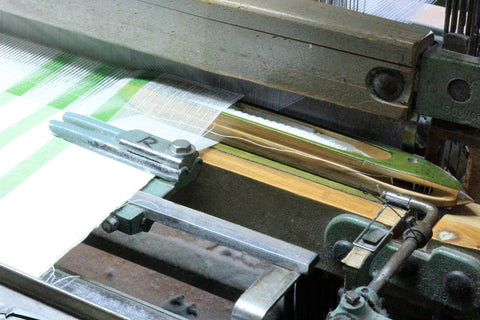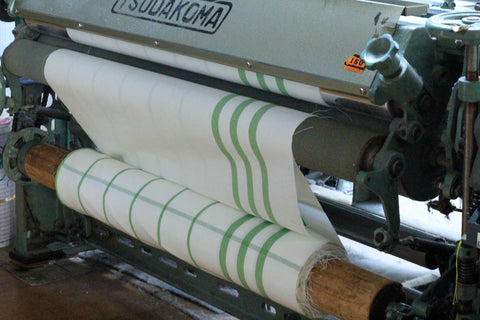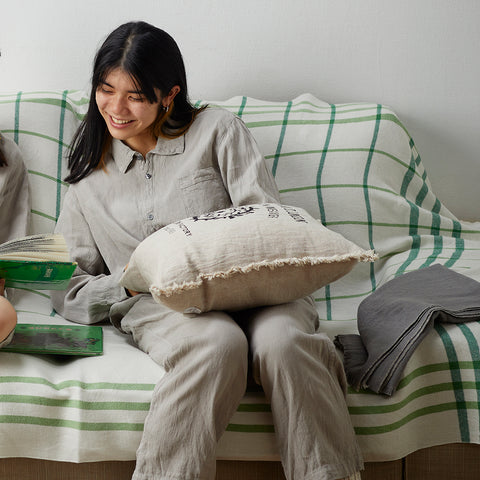The Routine Linen
Everyday linen
“Life is but a tissue of habits.”
— Henri-Frédéric Amiel
If we believe that, we can change our life by changing our habits. And I think that good habits are about having a good routine in our daily life. In this blog, I would like to introduce our products as things to accompany such a good daily routine.
Folding weave Blanket&Folding weave linen large cloth
Now, I would like to introduce the Folding Weave Series. It sounds somewhat unfamiliar, doesn't it? That is as it should be. The name "folding weave" is a term I coined. To explain it simply, this textile is like a newspaper. When you read a newspaper, it is folded vertically and unfolded. This textile is folded in two just like a newspaper. I will explain what this means step by step.

During the weaving process, the cloth becomes like a newspaper folded in two.

This is what it looks like during weaving.

As unfolded the newspaper to open it, another piece of cloth peeked out from underneath.

The left half is checkered and the right half is plain. And the whole is a framed pattern.
Folding weave is really a double weave
First of all, double weave is woven just like two layers of cloth. Double gauze is probably the most familiar to most people. It is often used for towels and clothing. Its characteristic is that it is a "single piece of cloth" woven from two separate pieces of fabric woven as if they were layered together.

The underside (back side) of the double weave is being woven. The underside cannot be seen because many warp threads are being pulled up.

This is a view of the top side being woven. When weaving the upper surface, the warp threads for the lower surface are not needed, so the number of warp threads to be pulled up is reduced and the check pattern on the lower surface is clearly visible.
The reason for double weaving
One of the usual reasons for double weaving, as in double gauze, is to soften the texture. By double weaving, the cloth is divided into upper and lower sections, and the contact points between the warp and weft yarns are reduced, resulting in a softer cloth. At the same time, the double layer of fabric becomes fluffy to the touch because it is filled with air.

Air layer is created between the top and bottom surfaces.
Folding weave with a different purpose than regular double weave
However, the purpose of double weaving in this product is a little different. The answer lies in the design. Let's take a look at the design. This design features a plain weave on one side, a check on the other, and a framed pattern throughout.

In the case of normal weaving, one weft thread runs from the left end to the right end. If half the textile is checkered, the other half could not be plain.
To give shape to the design
This product is a yarn-dyed fabric, meaning that the yarn is dyed first and then woven. Normally, one weft thread is woven seamlessly from the left end to the right end of the cloth. It means that the same color should continue from the left end to the right end. However, the design of this product is plain on one side and check on the other side. In a normal weave, the color of the checks should continue from one end to the other. However, that is not the case with this design. This is why we came up with the folding weave.

We thought we could give shape to the design by weaving one side (front) into a solid color and the other side (back) into a checkerboard pattern, and then unfolding it out.
Weaving unique to the shuttle loom
Our loom is a shuttle loom, which is now an obsolete loom. However, since the weft is woven in the same way as on a hand loom, a weft thread is always folded over at both ends of the cloth. It means that the weft is always connected. These two ends are called "selvage or selvedge In English. This selvage is what makes the folding weave possible.

The top and bottom surfaces are always connected at either end.

Folding weave cloth just after weaving.

The selvedges are made using a tool called a shuttle, which carries the weft yarn.

Weaving in progress.

On the right side, the cloth is clearly visible in two pieces.

The left side is not in two pieces because it is folded on this side.
We were thus able to create a checkered pattern on one side and a plain weave on the other half, but there was the last hurdle to overcome. When this product is unfolded and viewed as one large piece, it must be made into a picture frame pattern.

A picture frame pattern is like a pattern with a window frame, so weaving from the bottom to the top of the frame requires a significant amount of pattern paper. This product is more than 2m long before sewing, so the amount of pattern paper is enormous.

Once we have made a pattern paper like this, it is convenient to weave many more cloth, all of which will have the same pattern and length. One round of this paper is enough to weave one cloth. The reason this is such a large quantity of pattern paper is because the design is a framed pattern.
The double weaving technique and a large number of pattern papers are used to create this folding weave series. This is one of the proudest products.
Folding weave blanket(50%Linen, 50%Lambwool)


Folding weave lenen large cloth(100%Linen)


Finally, a piece of linen in the daily routine.

「Folding weave linen large cloth」
Read more
“Life is but a tissue of habits.”
— Henri-Frédéric Amiel
If we believe that, we can change our life by changing our habits. And I think that good habits are about having a good routine in our daily life. In this blog, I would like to introduce our products as things to accompany such a good daily routine.
Folding weave Blanket&Folding weave linen large cloth
Now, I would like to introduce the Folding Weave Series. It sounds somewhat unfamiliar, doesn't it? That is as it should be. The name "folding weave" is a term I coined. To explain it simply, this textile is like a newspaper. When you read a newspaper, it is folded vertically and unfolded. This textile is folded in two just like a newspaper. I will explain what this means step by step.

During the weaving process, the cloth becomes like a newspaper folded in two.

This is what it looks like during weaving.

As unfolded the newspaper to open it, another piece of cloth peeked out from underneath.

The left half is checkered and the right half is plain. And the whole is a framed pattern.
Folding weave is really a double weave
First of all, double weave is woven just like two layers of cloth. Double gauze is probably the most familiar to most people. It is often used for towels and clothing. Its characteristic is that it is a "single piece of cloth" woven from two separate pieces of fabric woven as if they were layered together.

The underside (back side) of the double weave is being woven. The underside cannot be seen because many warp threads are being pulled up.

This is a view of the top side being woven. When weaving the upper surface, the warp threads for the lower surface are not needed, so the number of warp threads to be pulled up is reduced and the check pattern on the lower surface is clearly visible.
The reason for double weaving
One of the usual reasons for double weaving, as in double gauze, is to soften the texture. By double weaving, the cloth is divided into upper and lower sections, and the contact points between the warp and weft yarns are reduced, resulting in a softer cloth. At the same time, the double layer of fabric becomes fluffy to the touch because it is filled with air.

Air layer is created between the top and bottom surfaces.
Folding weave with a different purpose than regular double weave
However, the purpose of double weaving in this product is a little different. The answer lies in the design. Let's take a look at the design. This design features a plain weave on one side, a check on the other, and a framed pattern throughout.

In the case of normal weaving, one weft thread runs from the left end to the right end. If half the textile is checkered, the other half could not be plain.
To give shape to the design
This product is a yarn-dyed fabric, meaning that the yarn is dyed first and then woven. Normally, one weft thread is woven seamlessly from the left end to the right end of the cloth. It means that the same color should continue from the left end to the right end. However, the design of this product is plain on one side and check on the other side. In a normal weave, the color of the checks should continue from one end to the other. However, that is not the case with this design. This is why we came up with the folding weave.

We thought we could give shape to the design by weaving one side (front) into a solid color and the other side (back) into a checkerboard pattern, and then unfolding it out.
Weaving unique to the shuttle loom
Our loom is a shuttle loom, which is now an obsolete loom. However, since the weft is woven in the same way as on a hand loom, a weft thread is always folded over at both ends of the cloth. It means that the weft is always connected. These two ends are called "selvage or selvedge In English. This selvage is what makes the folding weave possible.

The top and bottom surfaces are always connected at either end.

Folding weave cloth just after weaving.

The selvedges are made using a tool called a shuttle, which carries the weft yarn.

Weaving in progress.

On the right side, the cloth is clearly visible in two pieces.

The left side is not in two pieces because it is folded on this side.
We were thus able to create a checkered pattern on one side and a plain weave on the other half, but there was the last hurdle to overcome. When this product is unfolded and viewed as one large piece, it must be made into a picture frame pattern.

A picture frame pattern is like a pattern with a window frame, so weaving from the bottom to the top of the frame requires a significant amount of pattern paper. This product is more than 2m long before sewing, so the amount of pattern paper is enormous.

Once we have made a pattern paper like this, it is convenient to weave many more cloth, all of which will have the same pattern and length. One round of this paper is enough to weave one cloth. The reason this is such a large quantity of pattern paper is because the design is a framed pattern.
The double weaving technique and a large number of pattern papers are used to create this folding weave series. This is one of the proudest products.
Folding weave blanket(50%Linen, 50%Lambwool)


Folding weave lenen large cloth(100%Linen)


Finally, a piece of linen in the daily routine.

「Folding weave linen large cloth」



